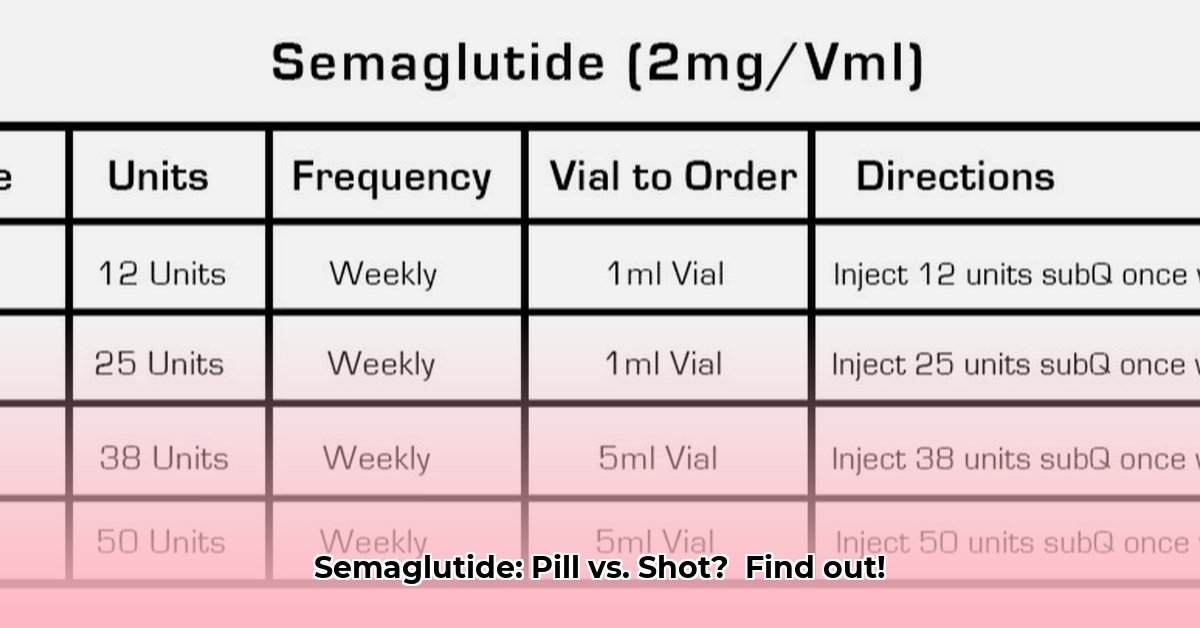
Choosing between semaglutide tablets and injections for weight loss can be confusing. Both deliver the same medication, but the delivery method significantly impacts efficacy, side effects, and convenience. This comparison guide clarifies the key differences to help you make an informed decision, in consultation with your doctor.
Understanding Semaglutide: A Weight-Loss Hormone Mimic
Semaglutide mimics a natural hormone in your body, GLP-1. This hormone regulates blood sugar and makes you feel full, potentially leading to weight loss. It's particularly effective for people with type 2 diabetes.
Injectable Semaglutide: Wegovy and Ozempic
Injectable semaglutide (brands like Wegovy and Ozempic) offers a direct route to your bloodstream.
Pros:
- Greater Weight Loss: Studies indicate injectable semaglutide generally leads to more significant weight loss compared to oral semaglutide. This is because a larger dose efficiently reaches your system.
- Established Efficacy: Extensive research supports the effectiveness and safety of injectable semaglutide for weight management.
Cons:
- Injections: The requirement for weekly injections is a significant drawback for some individuals.
- Stronger Side Effects: The rapid delivery of a larger dose can result in more noticeable side effects, such as nausea, diarrhea, and constipation. However, these often lessen over time.
Oral Semaglutide: Rybelsus
Oral semaglutide (Rybelsus) provides a pill-based alternative.
Pros:
- Convenience: Daily oral administration eliminates the need for injections, increasing adherence for many.
- Milder Side Effects (Potentially): The gradual release of a smaller dose may result in fewer and milder side effects compared to injections, although individual experiences can vary.
Cons:
- Lower Weight Loss Potential: The lower and slower absorption of semaglutide might result in less substantial weight loss, though individual responses differ significantly.
- Variable Absorption: The effectiveness of Rybelsus can vary across individuals due to differences in how well their bodies absorb the medication.
Comparing Effectiveness: A Detailed Look at the Research
While injectable semaglutide shows greater weight loss in many studies, individual results vary widely. Oral semaglutide remains promising, especially for individuals with type 2 diabetes managing their condition with insulin. Further research is crucial to fully understand individual responses and optimize treatment.
Side Effects: What to Expect with Each Formulation
Both injectable and oral semaglutide can cause gastrointestinal side effects, such as nausea, constipation, and diarrhea. However, these side effects are often reported to be more intense or frequent with the injectable form. Your doctor can discuss strategies to mitigate these effects.
Making the Right Choice: Consult Your Healthcare Provider
The best semaglutide option depends on individual health, lifestyle, and preferences. Consult your doctor to discuss the advantages and disadvantages of each based on your specific circumstances.
Key Considerations: A Summary Table
| Feature | Injectable Semaglutide (Wegovy, Ozempic) | Oral Semaglutide (Rybelsus) |
|---|---|---|
| Administration | Weekly injection | Daily tablet |
| Weight Loss | Generally greater weight loss | Potentially less; varies greatly |
| Side Effects | Potentially more intense | Potentially milder |
| Convenience | Less convenient | More convenient |
| FDA Approval | Wegovy: Approved for weight loss; Ozempic: Primarily for type 2 diabetes | Primarily for type 2 diabetes; often off-label for weight loss |
The Bottom Line: A Partnership with Your Doctor
Choosing between semaglutide tablets and injections is a personal decision best made in conjunction with your physician. Your doctor can help you weigh the benefits and drawbacks based on your unique health status and preferences to develop a weight-loss plan that suits you. Remember, a healthy lifestyle, including diet and exercise, complements any medication for optimal results.